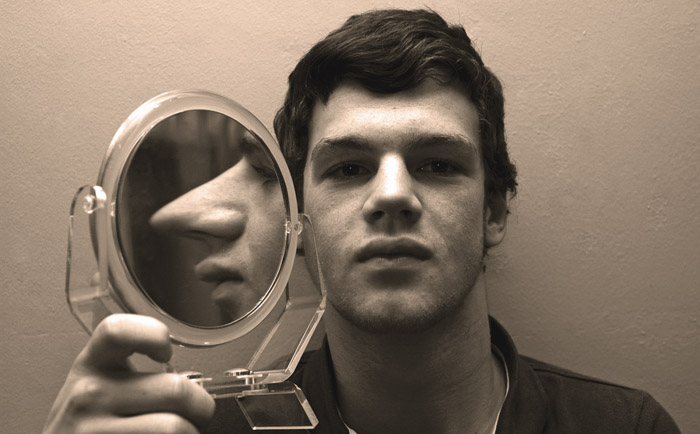Imagination and lying
The Wrong Turn
In our desire to liberate our inner selves and become a ‘true’ person, we need a good mind map that shows us where in our minds we constantly take the wrong turn, draw wrong conclusions or assumptions, allow wrong conditioning to persist, and so on.
It is important to understand how and why this happens within us. Because all these wrong workings of our wonderful versatile human mind keep us narrow-minded, dependent, very internally divided, and separated from others. They make us react automatically to our environment and to our own numerous inner impulses. They maintain limiting habits and give us the idea that we are ‘different’, even special, or that we are more or less important than others. Or even that we don’t matter and are ‘completely alone’.
These psychological processes, which occur unconsciously and are maintained through identification and keep us mentally narrow-minded, unhappy, and fickle, are often denied. They are denied because people are unaware of them, but also because people think they have already overcome them. Both assumptions are untrue and maintain inner unfreedom and thus the ego, because our ego consists solely of unconscious identifications and imaginations. This way, we create images of and about ourselves, others, and situations, and we no longer see reality. With all its consequences. This pseudo-reality, built from the past and projected onto the future, often keeps us completely out of the Now. It can bring a lot of feelings of unhappiness with it.
We will need to effectively pierce through these human illusions so that, after making a focused effort, we can shed ignorance and shortsightedness about our own inner self. This can be done by repeatedly bringing ourselves into self-remembrance, which will create an inner anchor within us.
Our thinking mind is clever in deceiving ourselves. It does this to obtain, in the absence of anything better, a false sense of security, because security is a basic need in everyone. And that leads to the persistent desire to maintain a comfort zone. Our mechanically operating mind in unconsciousness makes permanent use of two things: imagination and lying. Imagination and the lying that mainly stems from it are our biggest stumbling blocks to inner liberation.
What is Imagination?
Imagination stems from our human ability to create. From our ability to be creative, that is. Imagination gives rise to beautiful things like art, literature, organization, inventions, scientific discoveries, and so on. Human imagination is capable of a lot and is of enormous benefit to humanity – and its progress and prosperity. It also distinguishes us from the animal world, where the mental power of imagination is only very limited.
But just as our natural instrument for experiencing the connection between everything (Ahamkara) can turn into identification with all sorts of things in unconsciousness, our creative power of imagination creates an untrue image of ourselves when it is allowed to go ‘freely’ in unconsciousness. But it is far from free; it is a mechanically occurring phenomenon. Imagination can go its way because we do not perceive it and thus ‘allow’ it.
Through this incorrect imagination of ‘myself in the world,’ we create an incorrect self-image, an illusory ‘I’ who thinks and finds all sorts of things about itself and the world around it. This way, we even create multiple ‘I’s that we believe in, which alternately dominate in different situations. All together, this is our ego.
Imagination can go in two directions: either we are full of conceit and inner applause about ourselves, and then we feel okay. Here lies the ego trait of pride lurking. Or we are full of doubts or inner booing about ourselves, and we feel miserable. Then there is a depression lurking in our psyche. An ‘enlightened’ ego is just as limiting as an ego full of self-reproach.
This immediately creates a form of internal consideration. This leads to all kinds of undesirable, limiting inner attitudes. A few examples: we keep our cover on; we present ourselves differently than we feel; we underestimate or overestimate ourselves or others; we project feelings of discomfort outward, or we act cautiously in everything due to an underlying fear of strangers and the unknown. Needless to say, this is all not consciously perceived, and we can suffer a lot from it. To then relieve that burden, we unconsciously adapt even further to how we think it will be best for us, with rules, strategies, or compulsions and the expression of criticism (which is different from being critical) and we end up even further from home. Self-justification is a commonly used ‘tool’ here. Through imagination, we create a personal ‘reality’ in our experience and also the assumption that our environment will experience that ‘reality’ in the same way. A world according to me…
What is Lying?
From this inner world of imagination that we – at least temporarily – take as true, lying arises. Because from an untrue image of ourselves comes the justification of it (self-justification). So we have to embellish this false self-image with attitudes, statements, remarks, and/or excuses that must convince our outside world of its authenticity. Therefore, we make statements that are not true, adopt an attitude that we do not internally feel, or invent a beautiful or ugly story that forms the basis of who we think we are or want to be, and whose image we have created entirely ourselves. We can play the ‘good gentleman’, or ‘hard to get’, or ‘the contrary one’, or ‘the poor me’, or the ‘teacher’. The possibilities are endless. This lying happens all the time without us realizing it. We even maintain injustice with it.
‘Can you help me?’ someone asks. ‘No, I’m busy,’ is the answer. But one lies because they simply did not want to help. The cause of this lying is not noticed, let alone examined. Feigning affection is also a common lie (rule from the Desiderata )
Because we can carry multiple imaginary characters within us, which dominate depending on the situation, the lies that must support these self-images will also vary per situation. For example, someone may say in one situation, ‘I am a kind person, I live only from love,’ and in another situation, ‘I’m done with this, get lost!’ Different identities, with different selves, alternate and lie together an imaginary world aimed at ‘being someone’. Positive about themselves, or negative, the ego does not want to perish, no matter how it feels. There is no difference because it is all equally untrue. Every form of lying breaks the connection with ourselves and with others. We also often lie in response to an unpleasant truth (unconvenient truth). Then the mechanism of projection is used to return to the comfort zone.
Cause and Effect
There is, of course, a reason why we let this all happen within ourselves. It lies in our upbringing and culture. From our earliest childhood, we are filled with wrong examples and instructions, wrong assumptions and prohibitions, and many children are left to fend for themselves. In few families are children taught to be attentive, observant, and awake when things happen around them, but also when they feel or think something. Schools pay no attention to this. On the contrary, our education system is such that the natural alertness of children soon declines. Is there a school in the Netherlands that seriously offers lessons in awareness, self-reflection, self-remembrance, and connecting actions and speech…?
Thus, children, full of learned and identification-promoting thoughts and behavior, can soon lose their way and get caught up in self-images of all kinds. Many modern ‘diseases’ (such as stress, anorexia/bulimia, ADHD, gender confusion, but also the mental disruption that leads to senseless violence) are the result of this. Furthermore, this creates all sorts of so-called ‘real’ needs in children and young people, which are projected outward in search of fulfillment and can lead to a lot of unrest. Once physically mature, they lack mental and emotional maturity or purity.
Because there are almost no good examples and role models among adults, no adequate ‘therapies’ have been developed for children and young people who have become victims of very limited upbringing and schooling. Because adults rarely learn to truly wake up and liberate themselves inwardly after puberty. Thus, unconsciousness and suffering are passed from generation to generation. Many therapies and systems for behavior improvement are unfortunately developed by not truly conscious people, for even less conscious people.
Recently, there seems to be some change: mindfulness is now being introduced in some schools, which will particularly improve the awareness level of teachers. It will be able to protect the children from the consciousness fall to which they are now largely exposed because their discernment at that young age could not yet fully develop. This consciousness fall is an abandonment of being fully present in the Now, which is still so natural for children, towards an inner world of imaginations about accumulated past and future expectations. Only, mindfulness still lacks the pure and simple instructions that lead to the ability of self-remembrance. An ability that can eventually dissolve all mental ‘illnesses’ (read: inability to deal with things) that often arise from limited upbringing.
If we stop imagining all sorts of things and the lying that results from it, immediately when it happens to us again and we perceive it, a clear mental hygiene almost automatically arises within us. This is a state of Satya. Then we perceive our world of feelings and thoughts, which causes a possible underlying and hidden feeling, that has long wanted to be understood, to be exposed. By truly feeling, understanding, re-evaluating, and letting go of this, true inner freedom in inner unity arises.
Of course, this creation of a self-image and an imaginary reality is something we will have to give up and dedicate.
In our Christian tradition, there is the statement: “You shall not make for yourself a graven image, or any likeness of anything that is in heaven above, or that is in the earth beneath.” That this is now only understood as a physical image, such as a sculpture or icon, indicates lost knowledge.
This statement is about the mental images within us. Images of God, the Absolute, our Source, but also images of all earthly things, most importantly: the images of ourselves and others.
These images, all arising from imagination, limit us enormously and feed a continuous belief in falsehood and denial of ourselves and others. That this harms us, making us unhappy and unfree, is clear. Therefore, one sentence further in that part of Exodus it states: “for I, the Lord your God, am a jealous God,” which actually means that our inner imagery backfires on us like a boomerang. It is a universal law that is fulfilled. The mental projection mechanism always backfires on us.
This has absolutely nothing to do with a ‘physical’ God! Ignorance has made a caricature of God in our minds (a bearded man on a cloud who governs, gives, and takes) but also certainly in that Old Testament. The image that the Absolute (often called God) has received is absurd and shows the enormous loss of True knowledge over the centuries.
There is a beautiful old anecdote in the Zen tradition about lying, judging, and the conscience that arises from it.
 In a remote village, surrounded by hills and forests, lived a young monk named Koji in a small temple. He devoted his simple life to meditation and prayer. His presence was respected by the villagers, who often sought him out for advice and blessings.
In a remote village, surrounded by hills and forests, lived a young monk named Koji in a small temple. He devoted his simple life to meditation and prayer. His presence was respected by the villagers, who often sought him out for advice and blessings.
One day, a rumor spread through the village. A young girl named Mika became pregnant and claimed that the monk was the father. This caused a wave of excitement and indignation. The villagers were shocked and angry. They went to the temple where the monk lived and accused him of his misdeed. But Koji remained calm and unperturbed amid all the commotion. His only response to all the accusations was, “Is that so?”
The villagers, irritated by his apparent indifference, tried to challenge him, to convince him of his responsibility and to confess his guilt. But Koji remained calm and repeatedly said the same words: “Is that so?”
They even demanded that the monk take care of the child as atonement. Koji was willing to accept his responsibility, even though it could not be his child, and again he said “Is that so?”
Meanwhile, Mika struggled more and more with her secret. She was ashamed of her physical condition, but also for falsely accusing Koji, and was afraid of the village’s reaction if she told the truth. Eventually, under the pressure of her conscience, she confessed that the real father of her child was a young traveler she had fallen in love with, who had visited the village briefly and had already left.
When this truth came to light, the villagers felt ashamed and guilty about their hasty judgment and anger. They apologized to the monk and asked for his forgiveness. But Koji, still as calm and unmoved as ever, simply smiled and repeated his familiar words: “Is that so?”
The incident was a hard lesson for the village. They learned about the dangers of premature judgment, but also about the power of acceptance and compassion. The girl learned about the injustice that lying brings and learned to follow her conscience.
For Koji, the simple monk who had weathered the storm of accusations, life went on peacefully, his wise spirit unwavering in tranquility. Seeing this, the villagers could also forgive themselves.
There are several variations of this legend, including one in which, once the baby is born, it is given to the monk with the remark, “Here, take care of this child, after all, it is your child.” To this, the monk simply replied, “Is that so?” and took on the responsibility of caring for the child.


